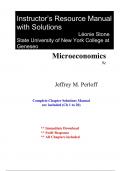Exam (elaborations)
Solutions for Microeconomics, 9th Edition Perloff (All Chapters included)
- Course
- Institution
Complete Solutions Manual for Microeconomics, 9th Edition by Jeffrey M. Perloff ; ISBN13: 9780137691432... (Full Chapters included Chapter 1 to 20)....1.Introduction 2.Supply and Demand 3.Applying the Supply-and-Demand Model 4.Consumer Choice 5.Applying Consumer Theory 6.Firms and Production ...
[Show more]



